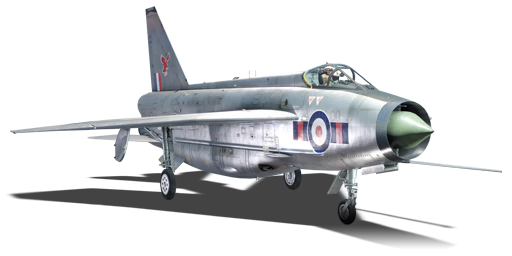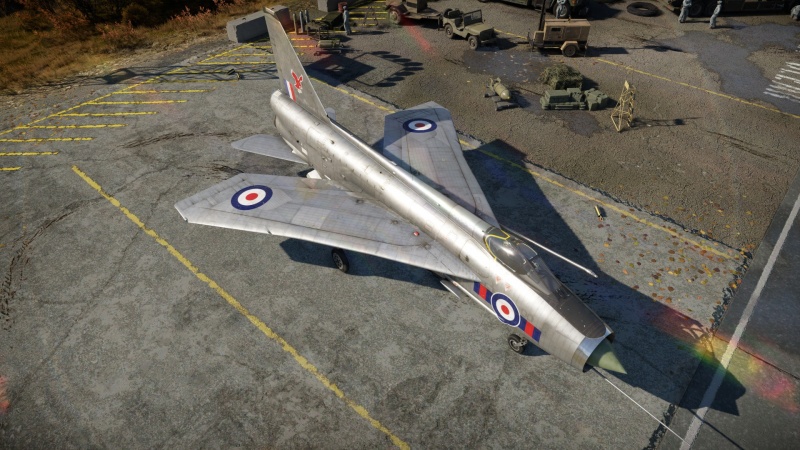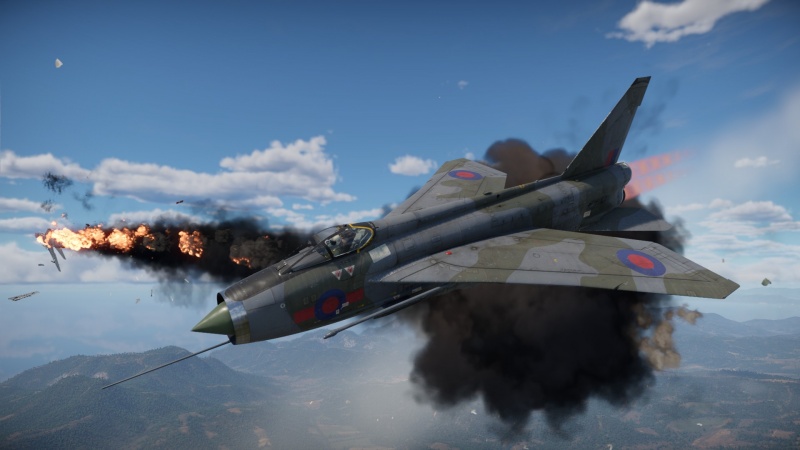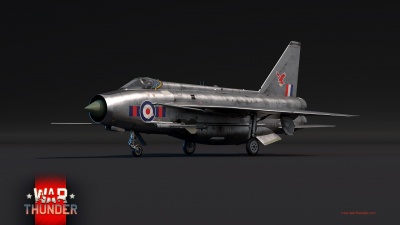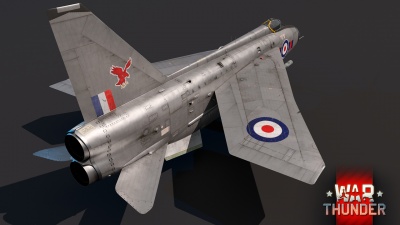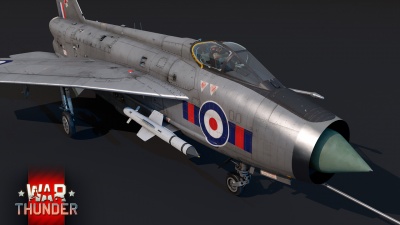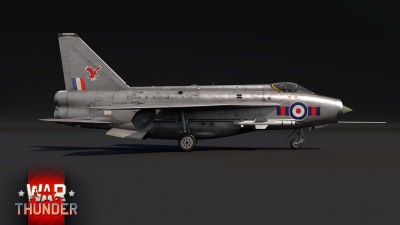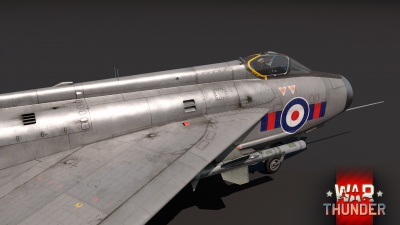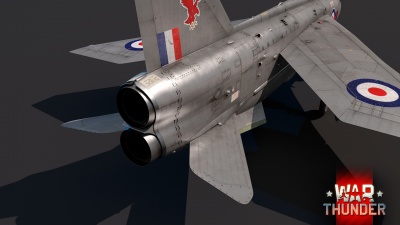Difference between revisions of "Lightning F.6"
Isaac_Victor (talk | contribs) (→External links) (Tag: Visual edit) |
Isaac_Victor (talk | contribs) m (→See also: added Lightning Family on see also) (Tag: Visual edit) |
||
| Line 299: | Line 299: | ||
* ''links to approximate analogues of other nations and research trees.'' --> | * ''links to approximate analogues of other nations and research trees.'' --> | ||
| + | * [[Lightning (Family)]] | ||
* [[Phantom FG. Mk1|Phantom FG.1]] | * [[Phantom FG. Mk1|Phantom FG.1]] | ||
* [[Phantom FGR.2]] | * [[Phantom FGR.2]] | ||
Revision as of 04:31, 14 April 2024
| This page is about the British jet fighter Lightning F.6. For the premium version, see Lightning F.53. |
Contents
Description
Development of the English Electric Lightning began in the late 1940s, following the cancellation of the Miles M.52 supersonic research aircraft program. It was designed as a high performance interceptor aircraft, to defend against Soviet bombers, with its unique stacked dual engine design. The Lightning F.6, entering service in December 1965, was the final production variant, and featured an enlarged ventral fuel tank, a new wing design, and reintroduction of the 30 mm ADEN cannons. The Lightning served as the RAF's primary interceptor throughout the 1960s and into the 1970s, and was gradually phased out of service in the late 1980s, being replaced by the McDonnell Douglas Phantom FGR.2.
Introduced in Update 1.97 "Viking Fury", the Lightning is a very distinctive aircraft, with its unique stacked engine design, highly swept wings, and large ventral fuel tank. It has decent acceleration, climb rate, and top speed; and can carry two Firestreak or Red Top missiles. While its missiles are not the best in the game they are still powerful weapons, although the limited quantity does require you to choose your shots carefully.
General info
Flight performance
The Lightning F.6 possesses good acceleration and climb performance, although arguably not as good as late model MiG-21s, and some Phantoms. The Lightning's two powerful Avon 302 engines do however give it the unique capability of being able to supercruise (fly supersonic without afterburner) at all altitudes, something very few other aircraft in the game can do. At sea level the Lightning can supercruise at Mach 1.03, with this generally increasing with altitude (for example at 5,000 m it can supercruise at Mach 1.07). The Lightning has a lower listed wing rip speed than other top tier jets such as MiG-21s and F-4 Phantoms, however it due to its powerful engines it is capable of reaching (and exceeding) this speed in level flight, even with a full missile armament. This means that the Lightning is actually faster than many of its competitors in a low altitude chase situation, being able to reach Mach 1.08 safely at sea level and Mach 1.10 if you want to push it (structural failure tends to occur at this speed so be careful); Mach 1.14 can be safely reached at 1,000 m. Enemy aircraft can still catch you if they are coming out of a dive, but a surprising number will not be able to keep up in a prolonged chase with a Lightning. Supercruise can be used to give the Lightning longer endurance than other top tier jets, without having to sacrifice speed.
In real life the Lightning's optimal climb profile was to accelerate to 450 knots (833 km/h) and then enter a climb, adjusting the climb angle to maintaining 450 kts / Mach 0.87 (whichever is lower)[1], and this method works well in game however a simpler approach can just be to accelerate to a reasonably high speed (around 1,000 km/h and enter a 30 degree climb). The Lightning is not a particularly manoeuvrable aircraft, however it can turn fairly well when at high subsonic speed and lower altitude, turning off the afterburner can also improve turning performance in some situations. The roll rate varies with speed and altitude, but is generally nothing special (bar a few speed / altitude combinations, where it rolls surprisingly well).
| Characteristics | Max Speed (km/h at 12,192 m) |
Max altitude (metres) |
Turn time (seconds) |
Rate of climb (metres/second) |
Take-off run (metres) | |||
|---|---|---|---|---|---|---|---|---|
| AB | RB | AB | RB | AB | RB | |||
| Stock | 2,240 | 2,213 | 16000 | 22.8 | 28.0 | 124.6 | 115.4 | 850 |
| Upgraded | 2,353 | 2,290 | 24.4 | 26.0 | 177.8 | 150.0 | ||
Details
| Features | |||||
|---|---|---|---|---|---|
| Combat flaps | Take-off flaps | Landing flaps | Air brakes | Arrestor gear | Drogue chute |
| X | ✓ | ✓ | ✓ | ✓ | ✓ |
| Limits | ||||||
|---|---|---|---|---|---|---|
| Wings (km/h) | Gear (km/h) | Flaps (km/h) | Max Static G | |||
| Combat | Take-off | Landing | + | - | ||
| 1361 | 463 | N/A | 654 | 463 | ~10 | ~6 |
| Optimal velocities (km/h) | |||
|---|---|---|---|
| Ailerons | Rudder | Elevators | Radiator |
| < 850 | < 700 | < 700 | N/A |
Engine performance
| Engine | Aircraft mass | |||||
|---|---|---|---|---|---|---|
| Engine name | Number | Basic mass | Wing loading (full fuel) | |||
| Rolls-Royce Avon Mk.302 | 2 | 14,020 kg | 436 kg/m2 | |||
| Engine characteristics | Mass with fuel (no weapons load) | Max Takeoff Weight | ||||
| Weight (each) | Type | 6m fuel | 20m fuel | 22m fuel | ||
| 1,310 kg | Afterburning axial-flow turbojet | 15,382 kg | 18,109 kg | 18,559 kg | 19,000 kg | |
| Maximum engine thrust @ 0 m (RB/SB) | Thrust to weight ratio @ 0 m (WEP) | |||||
| Condition | 100% | WEP | 6m fuel | 20m fuel | 22m fuel | MTOW |
| Stationary | 5,616 kgf | 7,413 kgf | 0.96 | 0.82 | 0.80 | 0.78 |
| Optimal | 5,616 kgf (0 km/h) |
7,747 kgf (1,000 km/h) |
1.01 | 0.86 | 0.83 | 0.82 |
Survivability and armour
In line with its role as a high-performance interceptor aircraft the Lightning F.6 has no armoured plating or bulletproof glass, such additions would have increased the weight of the aircraft, while offering no real benefit for its intended role.
Most of the inside of the wings (including the flaps) consists of fuel tanks, fuel is also stored in the ventral tank. The top engine is mounted above and to the rear of the bottom engine, this leaves it exposed to enemy fire; on the flip side the bottom engine is shielded from enemy fire by the top engine and wing fuel tanks, this makes is surprisingly resilient to damage, it is not uncommon for it to even continue functioning after the aircraft has been hit by a missile (although the rest of the aircraft will be well and truly broken afterwards).
The large belly tank and high wings of the Lightning mean it is able to survive belly landings very well.
Modifications and economy
The Lightning is a difficult aircraft to use when stock. If you particularly dislike the stock ADEN cannons then you may wish to priorities the cannon upgrades, however generally it is advisable to focus on flight performance and missile upgrades. Once you gain the ability to unlock tier 2 modifications you should prioritise the Red Tops, they are far from the best missiles in the game, but they can be useful; after that the new boosters modification is worth getting to improve the general handling of the aircraft. For tier 3 modifications you should get the wings repair and engine upgrades (unless you really want the ADEN upgrades). After this you can research the rest of the upgrades according to personal preference.
Armaments
Offensive armament
The Lightning F.6 is armed with:
- 2 x 30 mm ADEN cannons, mounted in belly tank (120 rpg = 240 total)
Suspended armament
The Lightning F.6 can be outfitted with the following ordnance:
- Without load
- 2 x Firestreak missiles
- 2 x Red Top missiles
Usage in battles
In combined battles, pilots of the Lightning F.6 may find themselves unable to deal much damage against ground vehicles, especially without the use of rockets, anti-tank missiles, or bombs. As such, this fighter is better suited to dealing with enemy air targets such as helicopters, which are plentiful at the Lightning's battle rating.
Although it faces challenges there, air realistic battles are where the Lightning truly belongs. The F.6 is able to use its Red Top missiles to dispatch enemies from a distance. Best practice with the missiles is to fire when there is about a 1.5 km gap between the F.6 and the enemy aircraft. This gap gives the missile time to lock on its target and track the enemy. One downside to the Red Tops is that they are not particularly fast compared to other missiles at its tier and may have trouble manoeuvring to catch an enemy aircraft travelling at top speed.
The Lightning F.6 handles well at subsonic speeds, although dogfights at those speeds are not common at this battle rating. Flying slowly leaves the pilot vulnerable to nearby enemies. Among those enemies may be the MiG-21 F-13, which the Lightning can often out-dogfight and the F-4C, which the Lightning has an extremely difficult time trying to out-dogfight. The Lightning just doesn't have the energy retention that the Phantom does.
Keeping this in mind, it is advised that pilots use this plane as part of a team, rather than as an attempted solo carry. It is recommended that they climb to higher altitude early on in the match and by gaining as much energy as possible before dumping it in dogfight manoeuvres.
Enemy planes that the Lightning F.6 is well-suited to take on in a fight are the Mitsubishi T-2, the F-100D, and the Mig-19s of all variants.
Radars
The Lightning F.6 is equipped with an AI.23 search and tracking radar. The radar is mounted in the nose of the aircraft.
| AI.23 - Target Detection Radar | |||
|---|---|---|---|
| Maximum Detection Range |
Guaranteed Detection Range |
Max Azimuth Scan Angle |
Max Elevation Scan Angle |
| 100,000 m (theoretical) |
50,000 m | ±50.0° | ±8.0° |
| AI.23 - Target Tracking Radar | |||
| Maximum Tracking Range |
Minimum Tracking Range |
Azimuth Tracking Angle |
Elevation Tracking Angle |
| 100,000 m | 300 m | ±50.0° | ±30.0° |
Pros and cons
Pros:
- Extraordinarily competitive climb rate & acceleration
- Can out-speed & out-accelerate aircraft even in a full up-tier
- Formidable angle-of-attack above low speeds
- Highly versatile missiles
- Capable of all-aspect tracking via radar slaving
- Unlikely to encounter countermeasures
- Surprisingly good turn rate between 800 and 1,000 km/h IAS
- Comparatively survivable
- One engine is sufficient to power aircraft
- Engines rarely overheat
- Enemies aiming centre-mass are unlikely to kill the pilot
Cons:
- Vulnerable to itself
- Can rip wings and avionics easily at 1,360 km/h IAS
- Very high fuel consumption when using afterburner
- Awkward cannon handling
- Cannons are mounted under the fuselage
- Low muzzle velocity
- Low fire rate
- Poor manoeuvrability
- Controls are unresponsive at low speeds
- Poor energy retention at high-subsonic speeds
- Avionics lock-up (compress) at transonic/supersonic speeds
- Lack of versatility
- No strike ordnance
- Engines run very hot and are therefore incredibly vulnerable to infrared-guided missiles
History
Background
In February 1946 the British government cancelled the Miles M.52 programme, only a few months before the first prototype was due to fly. The M.52 was a supersonic research aircraft, designed to reach speeds in excess of 1,000 mph (1,600 km/h) and potentially become the first aircraft to achieve supersonic speeds in level flight.[2] The cancellation sent a message to the aviation industry that the British Government had little interest in the development of supersonic aircraft. This did not deter English Electric Company engineer W. E. W. Petter; from his work designing the Canberra bomber he could tell that current fighters would be incapable of intercepting such an aircraft, and so began sketching designs for a new supersonic fighter.[3]
Petter lobbied the government to pursue supersonic aircraft development and in early 1947 presented his proposed design to the Ministry of Supply (MoS), to his surprise this lead to the MoS issuing specification ER.103 calling for companies to produce designs for a supersonic research aircraft capable of Mach 1.5 at 36,000 ft.[3] English Electric set to work on their proposal, which would later be known as the P.1.
Development
By the middle of 1948 most of the P.1's key design features were in place, the aircraft would have two engines stacked one on top of the other (this allowed for 2x increase in thrust while only increasing frontal area by 1.5x) and highly swept wings. English Electric was given a contract to develop the design further through 1949; wind tunnel testing indicated that the tailplane should be moved from the top of the vertical stabiliser to the bottom of the fuselage, and the wing sweep increased from 40° to 60°.[4] By the end of 1949 most of the P.1's design had been finalised.
In September 1949, the MoS released the first draft of specification F.23/49 laying out the requirements for a supersonic fighter aircraft. English Electric decided they could modify the P.1 design to meet the new F.23/49 specification. In April 1950, they received a contract to produce three prototype P.1 aircraft (two for flight testing and one for static testing).[4] Engineers at the Royal Aircraft Establishment (RAE) doubted English Electric's design for the P.1, believing that the aircraft should have had a 50° swept wing and kept the original high-mounted tailplane; this would lead to a second contract being handed to Short Brothers to produce an aircraft known as the SB.5. The SB.5 was a low-speed research aircraft (resembling the P.1) which facilitated the wings and tail being mounted in different configurations, with the aim being to find out whether English Electric or the RAE were correct. Later during testing it would be found that 60° was the optimal wing sweep and the high tail design would prove to be unstable in flight; proving English Electric correct in their design choices.[3]
In July 1952, while English Electric was working on building the P.1 prototypes, they were notified that the government intended to order a number of prototype fighters built to the F.23/49 specification, and so detailed design on the modified P.1 began. To avoid confusion, the two original P.1 aircraft would be known as P.1 and P.1A with the new fighter version known as the P.1B.[4] The official order for 3 P.1B prototypes was placed in August 1953 and was followed in February 1954 by an order for 20 P.1B development aircraft. The P.1 / P.1A were visually similar to the Lightning but had distinct differences; most notable were its use of non-afterburning Armstrong Siddeley Sapphire SA.5 engines and a significantly different cockpit and forward fuselage. The P.1 lacked the Lightning's distinctive shock cone intake, instead having a pear-shaped intake in the nose and also initially lacked the ventral fuel tank of production Lightnings. The P.1B was much closer to the production Lightning F.1 aircraft, being visually very similar, and incorporating most of the features of the production aircraft.[5]
The first P.1 was finished in May 1954 and taken to Boscombe Down, where it spent the next couple of months carrying out ground tests and fast taxi runs.[4] With tests progressing well, the first flight for the P.1 was set to be the 3rd August 1954. However, as test pilot Roland Beamont climbed into the cockpit for the first flight, he accidentally triggered the engine bay fire extinguishers; with the rest of the day spent cleaning up the fire retardant the flight had to be postponed until the next day.[3] The P.1 first flew on 4th August 1954, and shortly afterwards on its third flight it went supersonic, supercruising at Mach 1.02; in subsequent flights supercruise at Mach 1.08 in level flight would be achieved and in one flight the aircraft would eventually reach a speed of Mach 1.22.[4] The second P.1 prototype, known as P.1A, flew on 18th July 1955, featuring a ventral tank, twin 30 mm ADEN cannons mounted above the intake, and redesigned flaps.[6] While the P.1A was undergoing testing, the original P.1 prototype was modified with Sapphire SA.5R engines which produced less dry thrust than the SA.5's but featured reheat (afterburner) which gave them much greater thrust than the SA.5 when engaged. With the new engines the P.1 could reach Mach 1.56; the P.1A was never fitted with the new engines. During testing of the P.1, problems with the cockpit canopy became apparent, on one test flight in August 1955 while the aircraft was flying at Mach 0.95 the canopy broke away from the aircraft. The test pilot was able to land without further incident, and the canopy locking mechanism was adjusted; however a few weeks later the canopy broke loose again. After further modifications English Electric believed the problem was resolved; until once more the canopy came away from the aircraft, this time while the aircraft was flying at supersonic speed.[4] Following this incident, English Electric decided to completely redesign the canopy locking mechanism, finally fixing the issue, luckily none of the pilots were seriously injured in any of the incidents.[6]
The P.1B first flew on the 4th April 1957 and was successfully taken to Mach 1.2 on its first flight.[4] On the same day the P.1B first flew, the Government published the now infamous 1957 Defence White Paper, which cancelled most of Britain's advanced aircraft programmes under the (now known to be incorrect) belief that missile technology would make manned aircraft irrelevant; the P.1 was one of the few aircraft programmes not cancelled.[2] On the 23rd of October 1958 the P.1B was officially renamed to the Lightning.[4] Development of the P.1B continued with no major problems and on 25th November 1958 the P.1B became the first British aircraft to achieve Mach 2, sustaining it in level flight and with engines on the lowest of their four reheat settings.[4] Development continued with the last of the 20 P.1B pre-production aircraft taking to the air in September 1959;[6] this was followed by the first P.1B Lightnings being delivered to RAF service in December 1959.
RAF Service
The first production version of the Lightning to enter RAF service was the Lightning F.1, which differed only slightly from the pre-production P.1Bs, it entered service with 74 squadron at Coltishall in 1960.[5] The F.1 was powered by two Avon 200R engines each producing 11,200 lb of dry thrust or 14,400 lb of thrust with maximum reheat (afterburner).[7][3] In terms of armament, the F.1 had two 30 mm ADEN cannons mounted above the air intake and provision for three different interchangeable weapon packs to be fitted in the weapons bay. The most common weapons pack (and the only one most people are aware of) was the Firestreak pack; the internals of the pack contained electronic and cooling systems, while pylons protruding from either side of the pack allowed the lightning to carry two Firestreak air-to-air missiles, one on either side of the fuselage. The other two packs were less well known, one allowed the fitment of two additional 30 mm ADEN cannons (bringing the total to four), and the other allowed the cartridge of 48 x 2" unguided air-to-air rockets.[7] During normal flight the rockets would be stored internally, when the rockets were to be fired two launchers (each containing 24 rockets) would fold outwards from the weapon pack.[6]
A total of 22 production standard Lightning F.1s were built before production was switched to the improved F.1A standard. The F.1A was only slightly different to the F.1, featuring provision for an in-flight refuelling probe, some re-routed cabling from inside the engine bay to external cable ducts on the side of the fuselage, and Avon 210R engines; the engines had modifications to the reheat control system, but preformed the same as the Avon 200R engines of the F.1.[3][8] The F.1A entered service in December 1960 serving alongside the Lightning F.1s. The first two-seat Lightning trainers, known as T.4s were also delivered in 1960; the T.4 was based on the F.1A and featured two pilots sat side by side in the cockpit.[3] By 1965 the F.1s and F.1As had been withdrawn from front-line service, joining the T.4s in being used for pilot training and other duties into the 1970s.[3]
The next version of the Lightning to enter service was the F.2, planned as an interim version to enter service while the more advanced F.3 was still being developed. Externally it looked almost identical to the F.1A, with the only difference being the addition of a small air scoop on the "spine" of the aircraft. Internally however there were more changes; the engines were upgraded with fully variable reheat (instead of the 4 position reheat on earlier models), a significantly lighter and more compact oxygen system for the pilot, and an improved navigation system.[6] The F.2 entered service with two squadrons in 1961, and became the first Lighting variant to serve outside of the UK, being based at RAF bases in West Germany.[3]
After the Lightning F.2 came the Lightning F.3; which was a major upgrade over all previous models of the Lightning. The most obvious external feature of the F.3 was a new, larger, squared-off tail; this was necessary to allow the F.3 to safely carry the new Red Top missile. The Red Top was a major improvement over the Firestreak, having improved range, a more destructive warhead, and a new seeker giving the missile limited all-aspect capability. Internally, the F.3 featured a more advanced AI.23B radar, new navigation equipment, and most significantly new Avon 301R engines.[4] The Avon 301s produced significantly more thrust than previous Avon engines with 12,600 lb of dry thrust and 16,300 lb of thrust each on full reheat. The Lightning F.3 entered RAF service in January 1964.[2]
The F.3 was followed into service by the F.3A and the T.5 (a two-seat trainer variant of the F.3) in 1965. The F.3A was an interim version which designed to address the Lightning's limited range before the planned F.6 version was ready. The F.3A significantly increased the size of the ventral fuel tank, in addition it was fitted with a new wing featuring a kinked and cambered leading edge; this wing reduced subsonic drag leading to a 20% increase in cruising range. The new wing also improved the handling characteristics of the Lightning; it did however come at the cost of reducing supersonic acceleration.[4]
The final production model of Lightning to enter RAF service was the F.6. The Lightning F.6 had been intended to fix some of the shortfalls of the F.3; it included the enlarged ventral tank and new wing design of the F.3A, and returned the cannon armament with two 30 mm ADEN cannons mounted in the front of the ventral fuel tank. The F.6 also included support for a pair of over-wing fuel tanks, further improving the aircraft's range. The F.6 entered service in December 1965, serving alongside the F.3s; the superior range of the F.6 led to them being used for long-range interception missions, while the higher performance F.3 lent itself to being used for shorter range missions.[4] Although originally retaining the Avon 301 engines of the F.3 and F.3A, the F.6 would later be upgraded with Avon 302 engines; these engines provided better high altitude flight performance and reduced fuel consumption.[1]
The improved range of the Lightning F.6 proved popular with the RAF and so it was decided to rebuild 31 of the Lightning F.2s stationed in Germany to near F.6 standard.[2] These aircraft were known as F.2As and began entering service in 1968, they featured the enlarged ventral tank and new wings of the F.6, but retained the less powerful Avon 211 engines as well as the 30 mm cannons mounted in their original location above the intake.[9] As the F.2A also lacked the updated avionics of later models it was incapable of carrying Red Top missiles, instead carrying either Firestreaks or a gun pack containing two additional ADEN cannons.[9] The F.2A was well-liked by its pilots, the fitment of ADEN cannons above the intake allowed the entire ventral tank to be filled with fuel (instead of partly being taken up by cannons); coupled with less fuel-hungry engines this gave it the best endurance of any Lightning variant. The F.2A spent most of its service life carrying out low-level interceptions missions in Germany, where the increased endurance was greatly appreciated.[10]
The English Electric Lightning was the RAF's primary front-line interceptor from its introduction in 1959 up until the mid-1970s when it began to be replaced by the Phantom FGR.2. Even so, the Lightning would continue to serve in the interceptor role with the RAF until 1988, leaving RAF service less than two years before the first Phantoms began to be retired from service. Although the Lightning was primary used to intercept Soviet bombers entering UK airspace it was also stationed outside of the UK, most notably in Germany; the Lightning did also see service at RAF Tengah in Singapore and RAF Akrotiri in Cyprus.[10] Despite serving in the RAF for 29 years the Lightning never once shot down a hostile aircraft. Officially the only aircraft ever shot down by a Lightning was a pilotless Harrier; the pilot had ejected however the Harrier kept flying, it was decided to shoot it down rather than risk it entering Soviet territory.
Export Service
As well as RAF service, the Lightning did also see some export service with the Kuwait Air Force and Royal Saudi Air Force. The first Lightnings delivered to the Royal Saudi Air Force arrived in 1966; they came in the form of five Lightning F.52s and two T.54s. These aircraft were simply ex-RAF Lightning F.2s and T.4s.[11] Through 1968 - 1969 the Royal Saudi Air Force took delivery of more advanced Lightning F.53s and T.55s; the Kuwait Air Force would also receive its F.53s and T.55s in the same time span.[11]
The Lightning F.53 was effectively a Lightning F.6 upgraded to become a multi-role fighter. The most notable change was the addition of underwing hardpoints capable of carrying 1,000 lb bombs and SNEB rocket pods. In addition, the 2" rocket pack from the Lightning F.1 was returned to carry air-to-air or air-to-ground rockets, and a new photo-reconnaissance pack was made available, in addition to the Firestreak and Red Top weapon packs.[12] Various improvements were proposed for the F.53 including adapters to allow two bombs or rocket pods to be fitted to each underwing pylon, and dual rocket pods to be carried on the over-wing pylons (originally used for the fuel tanks on the F.6). While the dual underwing adapter would be approved for use on Saudi Lightnings the over-wing rocket pods never made it past mock-up stage.[4] The T.55 was a T.5 upgraded to better reflect the Lightning F.53; it received the enlarged ventral tank and new wings of the Lightning F.6 and F.53.[11]
Lightning F.6 compared to other variants
With the Lightning F.6 being the ultimate version of the Lightning in RAF service some may find it surprising to hear that it lags behind most other Lightning models in terms of raw flight performance. With the F.6 it had chosen to sacrifice the raw performance of previous Lightnings in order to improve the aircraft's range and return the cannon armament. As an example, a Lightning F.1 could accelerate from stationary to 450 kts (833 km/h) within 36 seconds of brake release; while an F.6 would take 42 seconds to achieve the same.[13][1] Likewise, from brake release to 36,000 ft would take 2 minutes 18 seconds in a Lightning F.1; while a Lightning F.6 would take 2 minutes 42 seconds.[13][1] By far the best performing Lightning variant was the F.3; it mated the much more powerful engines of the F.6 with the significantly lighter airframe of earlier Lightnings.
Devblog
Development of the Lightning began in 1947, after the Ministry of Supply issued a requirement for the development of an experimental supersonic aircraft, in order to gain insights on supersonic flight and aircraft design. By 1949 however, the requirements were changed to incorporate fighter levels of manoeuvrability, thus kicking off the development process which would eventually result in the Lightning.
While the first prototypes of the Lightning (P.1A) were designed to reach speeds of around Mach 1.5, in 1952, the decision was made to further develop a second batch of prototypes (P.1B), capable of reaching speeds of Mach 2. In August 1954, the P.1A prototype first took to the skies for its maiden flight, while the P.1B conducted its first flight in April 1957 and as the first British aircraft, reached speeds of Mach 2 in November.
Following a successful test phase, the Lightning was ordered into production and subsequently entered service with the RAF in 1959. The aircraft served throughout the Cold War period - until 1988 - with many variants being created which improved the Lightning's performance further, most notably increasing its originally very limited range.
With the advent of far more capable aircraft in the late stages of the Cold War, the over 330 Lightnings built were phased out of service in the late 1980s. Apart from its service with the UK, the Lightning also served with the armed forces of Kuwait and Saudi Arabia, the latter two being its only foreign operators.
Media
- Skins
- Images
- Lightning F.6 Devblog Images
- Videos
See also
External links
- [Devblog] Lightning F.6: Saddled to a Skyrocket!
- [Forums] Aircraft Data Sheets: Lightning F.6
- Cold War Lectures RAF museum podcast: English Electric Lightning: Evolution of the Concept of the All-Weather Fighter
References
- Citations
- ↑ 1.0 1.1 1.2 1.3 Lightning F.Mk 6, Operating Data Manual
- ↑ 2.0 2.1 2.2 2.3 Bowman 2009
- ↑ 3.0 3.1 3.2 3.3 3.4 3.5 3.6 3.7 3.8 Chorlton 2012
- ↑ 4.00 4.01 4.02 4.03 4.04 4.05 4.06 4.07 4.08 4.09 4.10 4.11 4.12 Ransom and Fairclough 1987
- ↑ 5.0 5.1 Burke 2016
- ↑ 6.0 6.1 6.2 6.3 6.4 Darling 2008
- ↑ 7.0 7.1 Pilot's Notes, Lightning F.Mk 1 & F.Mk 1A
- ↑ Roux 2007
- ↑ 9.0 9.1 Lightning F Mk 2A, Aircrew Manual
- ↑ 10.0 10.1 Pike 2011
- ↑ 11.0 11.1 11.2 Derry 2016
- ↑ Lightning F Mk. 53, Pilots Notes
- ↑ 13.0 13.1 Lightning F.Mks 1,1A,2 &T.MK.4, Operating Data Manual
- Bibliography
- Bowman, M. (2009). Lightning Strikes Twice: The Story of the English Electric Lightning. Stroud: Amberley Publishing.
- Burke, D. (2016). English Electric Lightning. Retrieved from Thunder and Lightnings
- Chorlton, M. (2012). The Lightning story - from P.1 to F.6. Aeroplane Icons, pp. 6-16.
- Darling, K. (2008). English Electric / British Aircraft Corporation Lightning Mks 1-6. Lulu.com.
- Derry, M. (2016). English Electric Lightning. Barnsley: Pen and Sword Aviation.
- Lightning F Mk 2A, Aircrew Manual. (1968). Warton Aerodrome, UK: English Electric Technical Services.
- Lightning F Mk. 53, Pilots Notes. (1983). Warton Aerodrome, UK: British Aircraft Corporation Ltd.
- Lightning F.Mk 6, Operating Data Manual. (1977). Warton Aerodrome, UK: English Electric Technical Services.
- Lightning F.Mks 1,1A,2 &T.MK.4, Operating Data Manual. (1975). Warton Aerodrome, UK: English Electric Technical Services.
- Pike, R. (2011). The Lightning Boys. London: Grub Street.
- Pilot's Notes, Lightning F.Mk 1 & F.Mk 1A. (1962). Warton Aerodrome, UK: English Electric Technical Services.
- Ransom, S., & Fairclough, R. (1987). English Electric Aircraft and their Predecessors. London: Putnam.
- Roux, E. (2007). Turbofan and Turbojet Engines Database Handbook. Lulu.com.
| The English Electric Company Limited | |
|---|---|
| Jet Fighters | Lightning F.6 · Lightning F.53 |
| Jet Bombers | Canberra B Mk 2 · Canberra B (I) Mk 6 |
| Tanks | Excelsior |
| The English Electric Company allowed the Glenn L. Martin Company to license-build Canberra bombers for the United States Air Force. | |
| Britain jet aircraft | |
|---|---|
| Blackburn | Buccaneer S.1 · Buccaneer S.2 · Buccaneer S.2B |
| British Aerospace | Harrier GR.7 · Sea Harrier FRS.1 (e) · Sea Harrier FRS.1 · Sea Harrier FA 2 |
| British Aircraft Corporation | Strikemaster Mk.88 |
| English Electric | Canberra B Mk 2 · Canberra B (I) Mk 6 · Lightning F.6 · Lightning F.53 |
| Gloster | Meteor F Mk 3 · Sea Meteor F Mk 3 · Meteor F Mk 4 G.41F · Meteor F Mk 4 G.41G · Meteor F Mk 8 G.41K · Meteor F Mk.8 Reaper |
| Javelin F.(A.W.) Mk.9 | |
| de Havilland | Vampire F.B.5 · Venom FB.4 · Sea Venom FAW 20 · Sea Vixen F.A.W. Mk.2 |
| Hawker | Sea Hawk FGA.6 · Hunter F.1 · Hunter F.6 · Hunter FGA.9 · Harrier GR.1 · Harrier GR.3 |
| Panavia | Tornado GR.1 · Tornado GR.4 · Tornado F.3 · Tornado F.3 Late |
| SEPECAT | Jaguar GR.1 · Jaguar GR.1A · Jaguar IS |
| Supermarine | Attacker FB 1 · Attacker FB.2 · Scimitar F Mk.1 · Swift F.1 · Swift F.7 |
| Foreign | Phantom FG.1 (USA) · Phantom FGR.2 (USA) · F-4J(UK) Phantom II (USA) |
| Australia | F-111C |
| India | ▄MiG-21 Bison |
| South Africa | ▄JAS39C |


